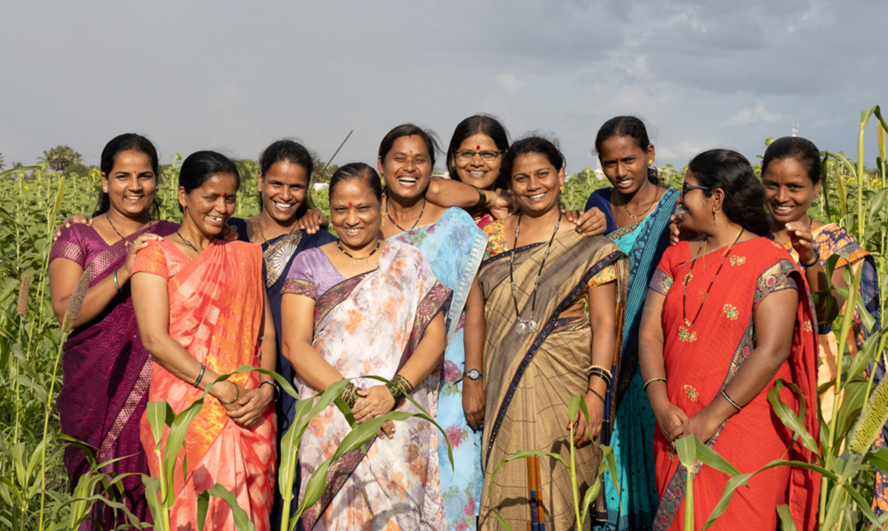Apr 2025
Fireside Chat with Anagha Kamath on Women Leading Climate Action

1) What unique role do women and girls play in leading climate action at the grassroots?
At Mann Deshi, we have seen firsthand that rural women are not just beneficiaries of climate action - they are its leaders. Women don’t just ‘play a role’ - they are the backbone of climate resilience. Women are the ones managing water resources, nurturing soil, and rearing animals. Their deep, everyday engagement with the land, water, and plants gives them an intrinsic understanding of sustainability. In our drought-prone Mann taluka, for example, through our sustainable agriculture trainings delivered by Soil Sakhis, women farmers are adopting climate-resilient agriculture practices, from soil testing, organic fertilizer making to crop diversification, making rural communities more sustainable. Their leadership, however, remains invisible in mainstream policy discussions. Recognizing their role is crucial, otherwise climate action will fail at the grassroots.
2) What are some structural and social challenges women face in implementing climate solutions?
In my opinion, one of the biggest challenges is land ownership. Women nurture and cultivate the land - the bulk of the agricultural work - but in many cases, they don’t legally own it. Without land titles, they struggle to access credit or government schemes for climate adaptation. Additionally, social norms often prevent women from attending training programmes, traveling for markets, or making financial decisions independently. At Mann Deshi, we have seen women overcome some of these barriers through collectives and cooperatives. For example, through Mann Deshi Kisan Producer Company, women farmers have formed groups to negotiate better prices, access markets directly, organize exposure visits and invest in farm machinery. It is our experience that when women come together, they gain not only economic strength but also greater bargaining power in their households and communities, enabling them to drive climate solutions at scale.
3) How can policies and funding mechanisms be better designed to support women’s leadership in climate action?
Policymaking must shift from a top-down approach to truly listening to women on the ground. Policies need to recognize women as farmers and entrepreneurs, not just as laborers. They need to recognize unpaid and informal work as essential to climate resilience. Government schemes and subsidies should be directly accessible to individual women farmers and women-led groups. Climate financing must also shift to models that support small-scale women entrepreneurs. It must prioritize women farmers and their collectives, just as it does for large agribusinesses. At Mann Deshi, we have developed a pre-credit score that allows women to access financing based on their economic activities and assets, including ownership of animals, even if they lack formal credit history. Instead of large, corporate-led interventions, small, flexible credit products can allow women-led businesses to adopt technologies like solar-powered irrigation, weather forecasting stations. This is something we are working towards, because without economic autonomy, no amount of training or capacity-building alone will help them.
4) How can traditional and indigenous knowledge held by women be integrated into mainstream climate solutions?
Women have always practiced sustainable agriculture, but their knowledge is often ignored. At Mann Deshi Centre for Sustainable Agriculture, we have worked with rural women farmers to listen to their “ancient intelligence” and see how we could complement and supplement it with modern agronomy and technologies. Instead of replacing these practices with high-cost, chemical-intensive farming, agricultural policies should support and scale women’s indigenous knowledge. The problem is that mainstream climate policies are written in boardrooms and, not in the fields and not by farmers. We must stop treating indigenous knowledge as folklore. Women’s knowledge of soil conservation and cropping practices and patterns have sustained communities for centuries. Instead of dismissing it as ‘unscientific,’ it should be documented and integrated into agricultural research, climate and conservation policies.

5) How can small-scale women-led initiatives be scaled while ensuring they remain community-driven and sustainable?
Scaling doesn’t mean turning community projects into large bureaucratic programmes. Instead, it should mean replicating successful local models across communities. Through our “Sheti Shalas” (agricutlure workshops on farmers fields), we have focused on peer learning, where one woman’s success in sustainable farming becomes a model for others in her village. For example, we trained groups of women in practices such as drip irrigation, silage making, and they, in turn, trained others, creating a network effect. This model ensures that growth remains community-led rather than imposed from the outside. We have also leveraged our community radio station to promote innovative and good practices across communities. The key is to always listen to women and “never provide poor solutions to poor people”!
6) What role can collaborative partnerships play in strengthening women’s leadership in climate action?
Farmers - especially women farmers - are among the most vulnerable actors in the climate change cycle. Yet, they are often expected to single-handedly adopt climate solutions without adequate support. True resilience can only come when the entire ecosystem works to reduce their risks - whether financial, technological, or market-related. We cannot look at agriculture solely from a climate lens - the livelihood lens is just as critical. Women farmers are not just protecting the environment, they are also feeding their families and sustaining their communities. Any climate solution that does not account for their economic realities risks placing an unfair burden on them, making it unsustainable in the long run. This is where effective partnerships can make a difference. Financial institutions can co-create solutions with women farmers by offering low-interest loans for solar energy, climate-resilient agriculture, and livestock management rather than imposing external models. Public-private partnerships must also ensure access to technology and knowledge. Collaborations should invest in capacity building, amplify women’s voices in policy discussions, and integrate their knowledge into mainstream solutions. And such partnerships should move beyond merely training to investments in women-led agri-enterprises. By creating financially viable, locally-driven, and de-risked solutions, we can ensure that women not only survive climate change but thrive as agents of change.
7) How do you see the future of women-led climate leadership evolving in India?
At Mann Deshi, we are seeing how women farmers are already leading the way - organizing collectives, adopting innovative agri-business models, and using digital platforms to secure better prices. But let’s be clear - their leadership is happening despite the system, not because of it. It is critical to give women land rights. Without this, they remain locked out of credit, government schemes, and decision-making power - a reality that keeps them at the margins of policy and finance. With it, younger women, who today see farming as hardship, will invest in technology and machinery, improve efficiency, and lift their families out of poverty. Farming will no longer be a cycle of subsistence and survival - it will be a path to prosperity.
Across India, women are leading struggles for water, land, and forests. These are the fundamental battles of climate justice, yet their voices remain unheard in policy making circles. Women are not protecting the soil, conserving water, and nurturing biodiversity because of a climate agenda - they do it because it is second nature to them. For generations, they have treated the land not as a resource to be exploited, but as a lifeline that sustains them. They do not need to be “taught” sustainability - they are already practicing it, while the rest of us are talking about it. If we truly want a feminist, community-driven future in climate action, the question is not whether women will lead - but whether we are ready to follow.
